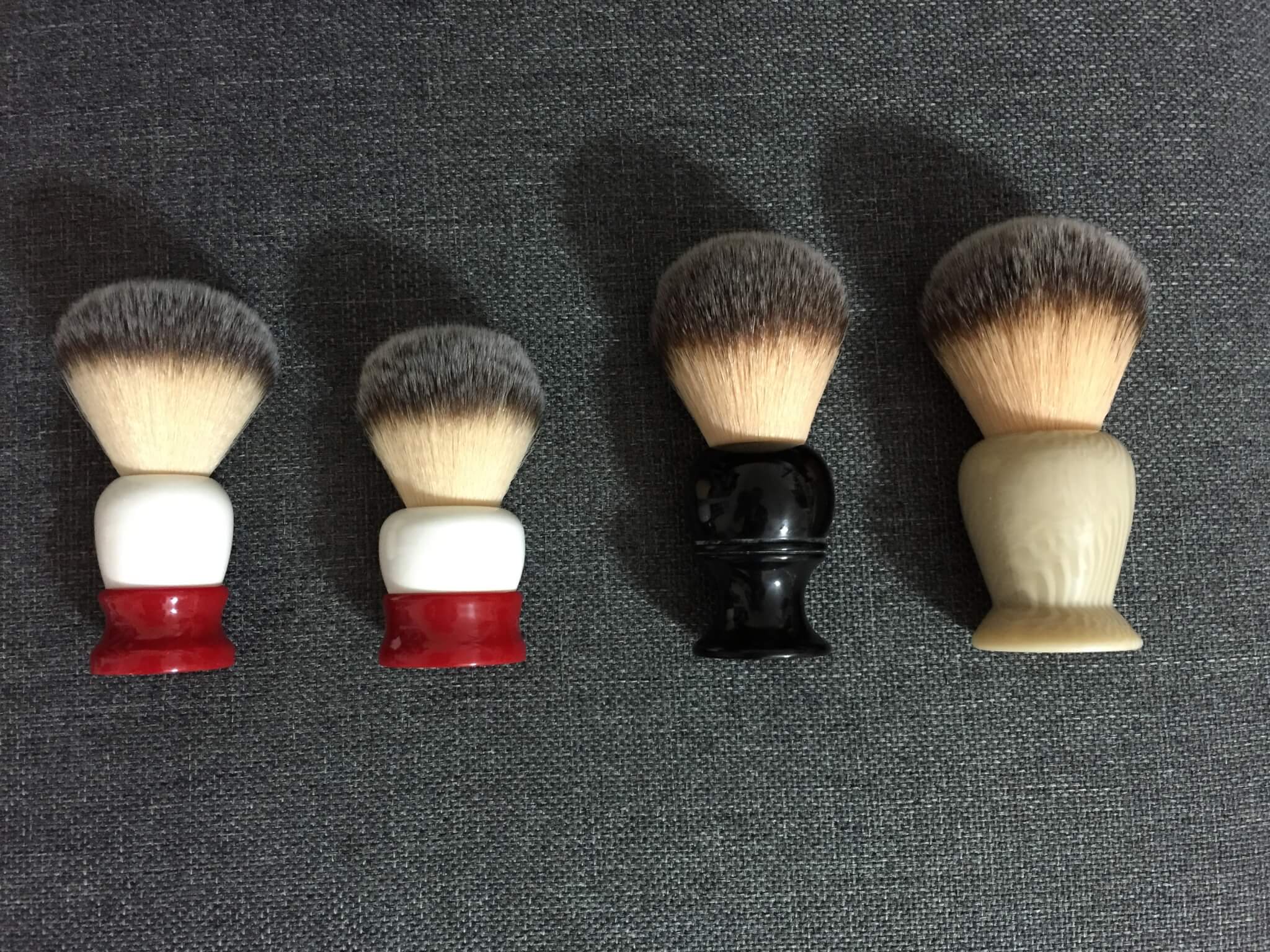
As Craig K covered here, the Plisson-like knots in synthetic shaving brushes have led to a renaissance of synthetics, if you will. Never before have such a large number of good quality, affordable shaving brushes been available. I took the opportunity to acquire a few and give them a try.
On the shelf today are:
- RazoRock Monster 26mm
- Fine Accoutrements Stout 24mm
- Fine Accoutrements Classic 20mm
- Maggard’s Razors 24m
A word on knots
A brush is the handle and knot of hair or fiber coming out of one end. The knot is specifically the hair or fiber portion. It’s called a knot, because it’s a small, tightly packed cluster, in this case, of fiber. This definition has fallen out of common use, but it’s still in use in this context.
We measure the diameter of the glue plug of a knot as the diameter of the knot. The loft is how high the knot is from where the fibers can flex. If a knot is sold bare, outside of a handle, it’s the height of the fibers above the glue plug. If it’s in a handle, the loft is the height above the handle. If a brush maker cares to disclose more information, you may get the total loft, and a measurement of how deep the knot is sunk in the handle. By sinking the knot lower and exposing shorter amounts of fiber above the surface, the knot gains a little more springy resistance as you apply it to the face. This isn’t necessarily a common measurement to get, and more complicated, not everyone measures the same way: Some people prefer to measure the hole drilled in the handle for the knot as the knot size. For example, a knot may be 24mm, but the hole in the handle to accept the knot may be 26mm in diameter. Some people may call these a 26mm knot. Those people are mistaken. The point of drilling a hole like this is so that as you sink the knot lower, the brush’s fibers spread unimpeded by the diameter of the handle hole. For example, Nathan Clark, a popular knot seller, makes recommendations on his Etsy product pages regarding what handle hole diameter, depth, for each diameter knot he sells.
Shedding
It is normal for a brush, especially a natural (badger, boar) brush, to shed a little when new, it’s not a good first impression. Normally, a brush maker may comb their brushes before shipping in order to get all of the loose fibers before the user receives it. A brush should shed all it’s going to shed in the first couple of uses. If it’s still shedding after a week, the knot may be suspect, and replaced. There’s a common perception that synthetics do not shed. That wasn’t my experience across any of the brushes on hand here. If your brush sheds, and you’re not certain, contact the vendor and see what they think about it.
Synthetics
Synthetic fibers have been used for years. They’re all primarily nylon. The quality, as in polyester clothing, has steadily improved over time. The synthetic knot of a few years ago is not the same quality knot you can buy affordably today.
All of these brushes are emulating the Plisson knot introduced in 2013. This knot is a soft knot, largely yellow, capped by soft dark gray ends. The ends don’t have to be gray; they could be any color, but gray is the commonly produced colorway.
Unlike with an animal hair brush, the color has no bearing on how soft or scratchy the knot is.
Care and Feeding
It’s important to care for your brush if you want it to last a while. When preparing for use, I wet the fibers of the knot, give a quick shake to get the water out, and proceed to load. I load by moving the brush back and forth across the top of the soap puck. I don’t move the brush in circles, and don’t splay it out much, just enough to apply some pressure to load the brush with soap. When I build lather, I bowl lather using paintbrush strokes. Avoiding splaying and avoiding circular motions prevents the brush from taking on a donut hole shape in the middle of the brush. Some men insist on splaying the brush out and moving in a circular motion while face lathering. If the intention is to build lather, I suggest you can do it as well with paintbrush strokes. If the intention is, as I’ve heard some folks say, to lift the hairs into the lather and exfoliate, well, I have this to say: If you think you’re exfoliating with the brush, what are you doing with the blade? It occurs to me that the blade will remove dead skin far more effectively than abusing your poor old brush will. Some like the feel of massaging their face with the brush. Fine and well, it’s your brush. Use it how it works best for you. When done, rinse the brush, gently squeezing to get all the lather out of the knot. When it runs clear, shake it briskly, and give it a few paintbrush strokes against a towel before sitting it on its base to let dry. If you use one as a travel brush, please do not put it away immediately after use. It is possible for bacteria to grow in any brush, which can be difficult to clean.
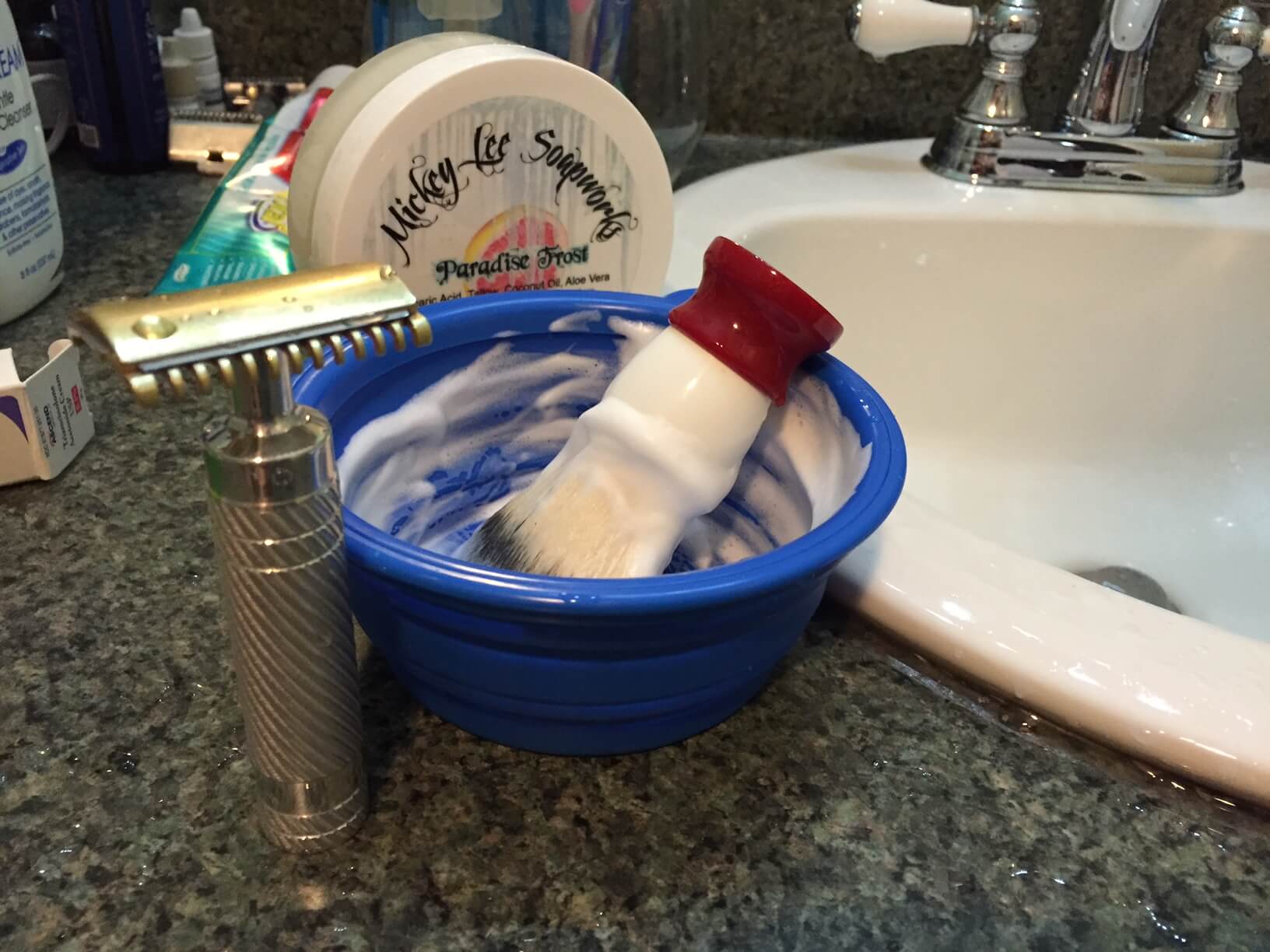
RazoRock
The Italian Barber of Canada has been outdoing himself recently, releasing a trio of brushes he calls the “Plissoft.” The largest of these is the Monster, with a 26mm knot and a 63mm loft rising above the handle. It’s a secret how much of the knot is sunk below the surface of the handle, because this determines the character of the backbone of a brush.
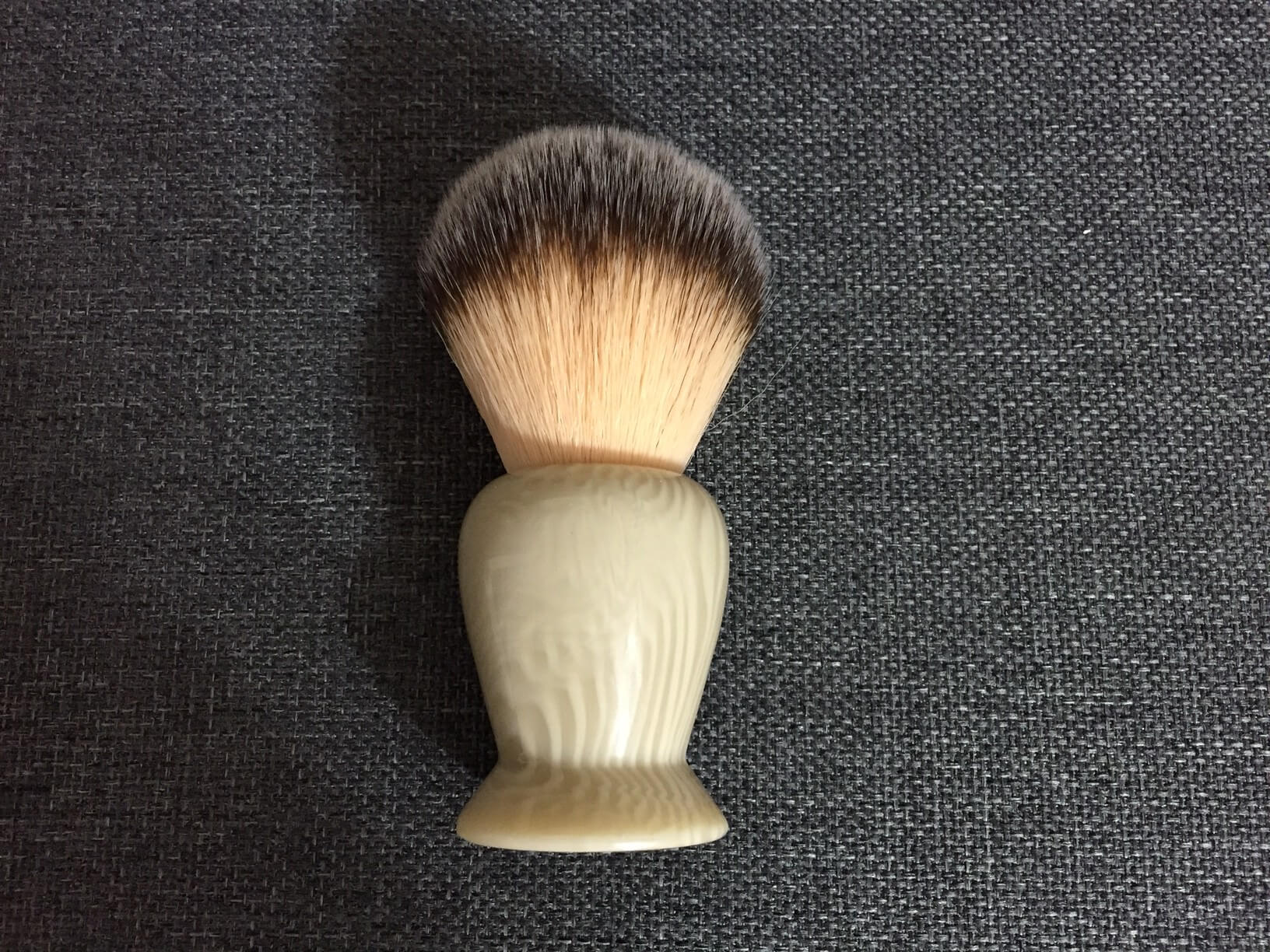
The 26mm Monster, and it is big, began somewhat inauspiciously by shedding as much as 16 fibers. There may have been more, but this was all I could recover.
The handle is huge, both tall and wide, with a pinched waist near the base of the handle to make it easy to hold.
Despite the synthetic springiness, when overloaded with lather, it flattens out against the face on applying paintbrush strokes. It’s not exactly floppy, but it may be the best approximation of floppy that a synthetic can do.
The brush lathers well, and its amount of springiness seems to be tempered a bit by the length of the fibers. It doesn’t seem to be set especially deep. It loads a little slower than the others, but not so much as to be a problem – it also holds more. The RazoRock Monster shed 12 fibers on arrival, just taking it out of the box. It continued to shed a few more for the first week, and then settled in. Joe, the proprietor of ItalianBarber, says that the shorter fibers may shed, but that it should stop doing so after the first week. My experience bears that out. The RazoRock Monster Plissoft is available for $10.99 from ItalianBarber.com
Fine Accoutrements Stout
The Stout is a chubby little brush, with an unusually dense and low-set knot for a 24mm. This has the effect of giving the brush a noticeable backbone, and strangely for synthetics, a bit of a scrubby feel on the tips of the brush.

Synthetics are normally soft, described as clouds grazing against the face. This one has a bit of feel to it. It’s not far off in feel from a 24mm Frank Shaving Finest Badger I have in this respect. It works well, and shed perhaps 1 inconsequential fiber. The Fine Accoutrements Stout is available from fineaccoutrements.com for $25.
Fine Accoutrements Classic
The Classic is an easy-to-hold 20mm with an angel soft face-feel. I usually prefer larger knots with greater loft, but this feels just fine to me. At 20mm, it definitely is composed the way knots were of old, and the handle is great in the hand. The brush works well, is soft, lathers up well, and would make a fine brush for a beginner, a travel brush, or an all-arounder on the smaller side. It is absolutely perceptibly softer on the face than it’s chubbier sibling.
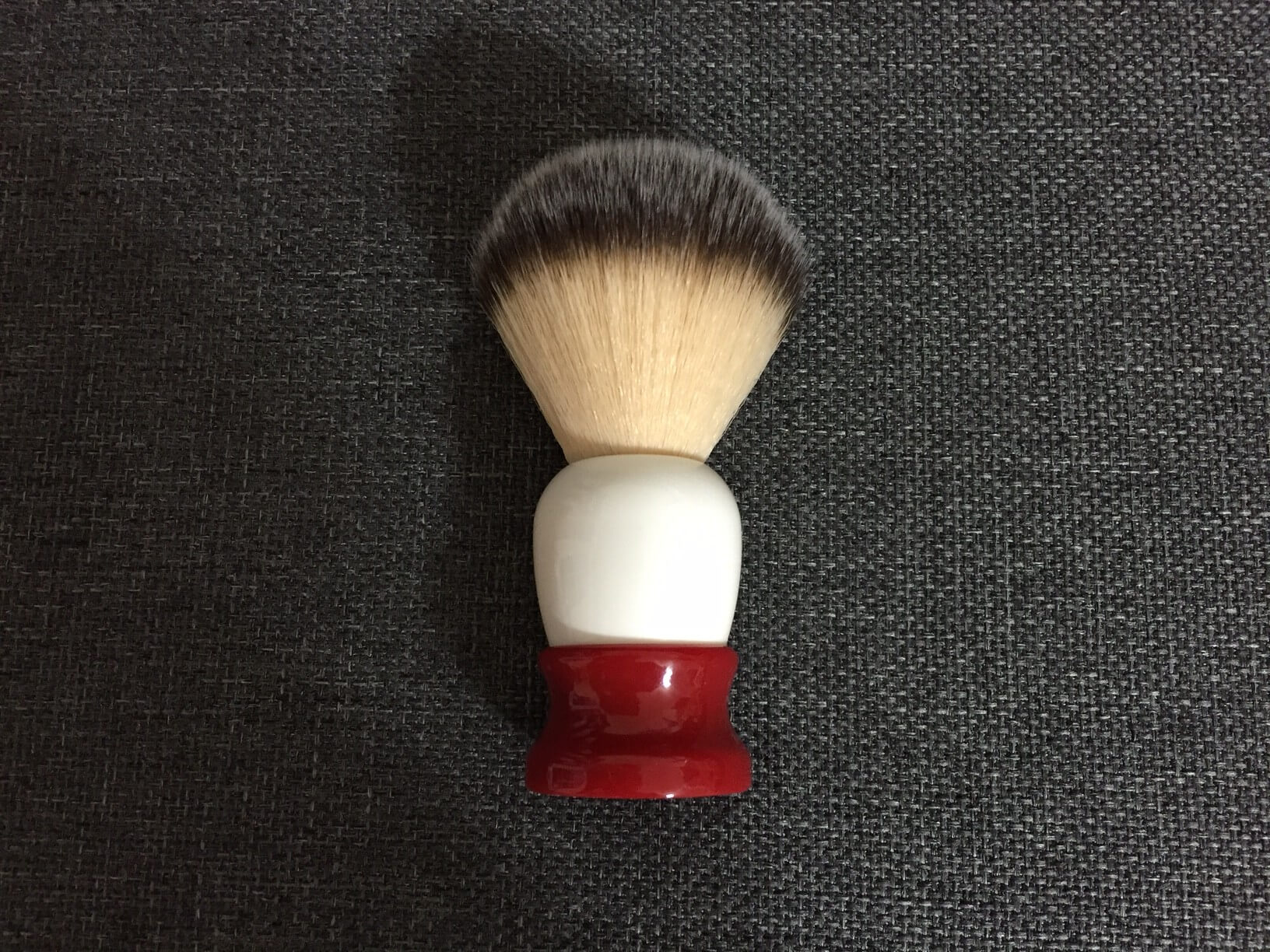
The brush sheds a fair bit, having lost 7 hairs that I’ve recovered. Mr. Fine comments, “On the synthetic brushes, some shedding in the first few weeks is normal, but it shouldn’t persist after that.” The Fine Accoutrements Classic is available from fineaccoutrements.com for $20.
Maggard’s Razors 24mm
While the Maggard’s Razors 24mm synthetic is the same size knot as the Fine Accoutrements, the two share very little in common. They’re both brushes with synthetic fiber, but there the differences become pronounced. The Maggard’s is set higher, and retains the springy character of synthetic brushes, but doesn’t have the backbone that the Fine 24mm possesses.
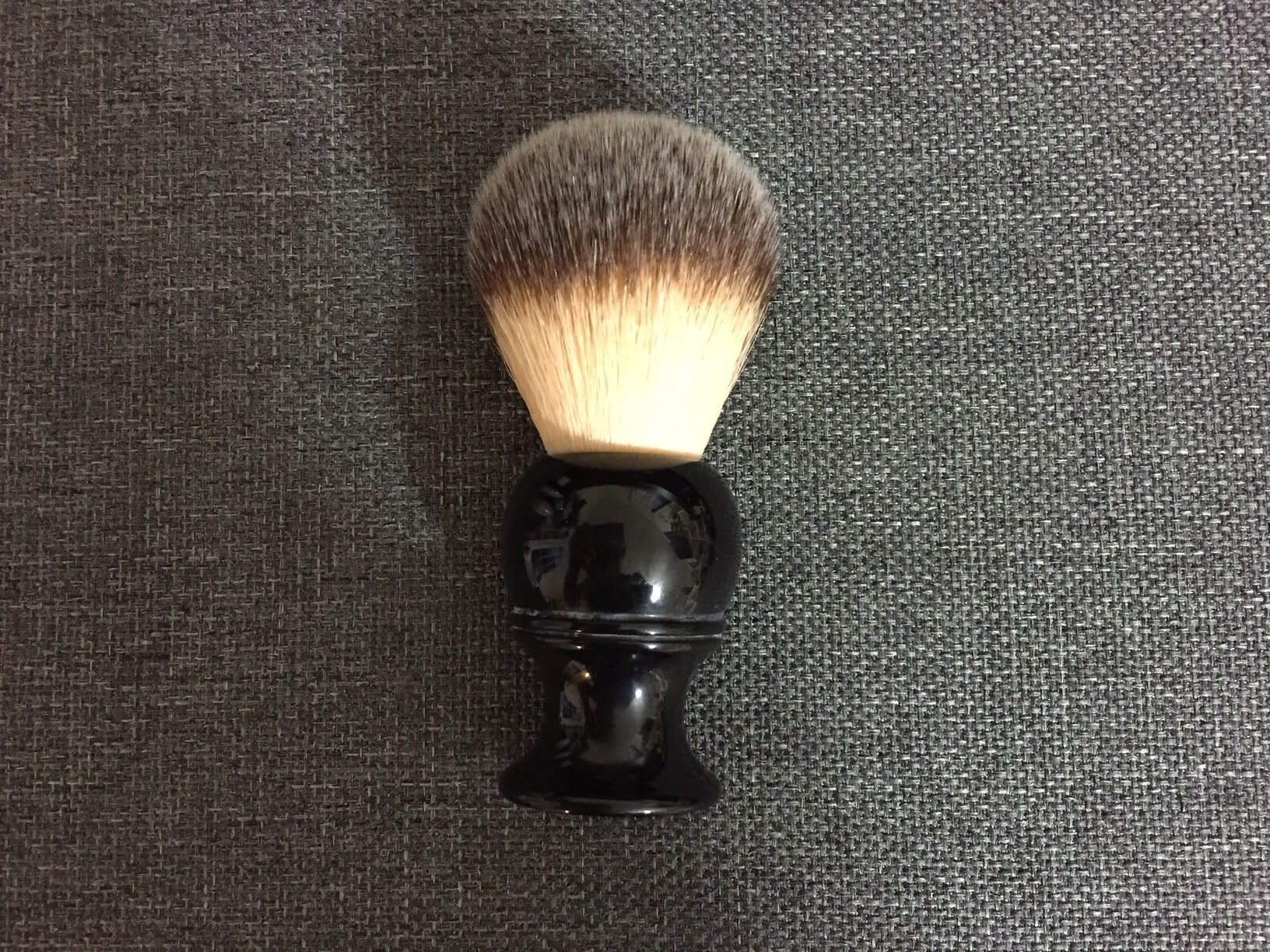
It’s much more like the RazoRock Monster in a smaller diameter. The handle is available in colors, although I purchased the black handled model. It’s perfectly fine as a brush, but I wouldn’t buy it again if I had the choice. The shape of the handle is nice enough to look at, but the shape of the handle at the bottom of the base, where I tend to hold my handles, is uncomfortable in my hand. Even the large RazoRock Monster was more comfortable, in part due to the way the Monster tapers up gradually to a pinched waist. The Maggard’s handle scallops quickly from the large flat disc of its base. Maggard’s Razors brushes are available from Maggardsrazors.com for $11.95
DIY
It’s entirely possible that the idea of a synthetic tickles your fancy, but none of these appeal to you for a variety of reasons: you want to choose a knot in a different size, you want to set it deeper, or you want to purchase your knot from a specific seller. There are a range of options available to you.
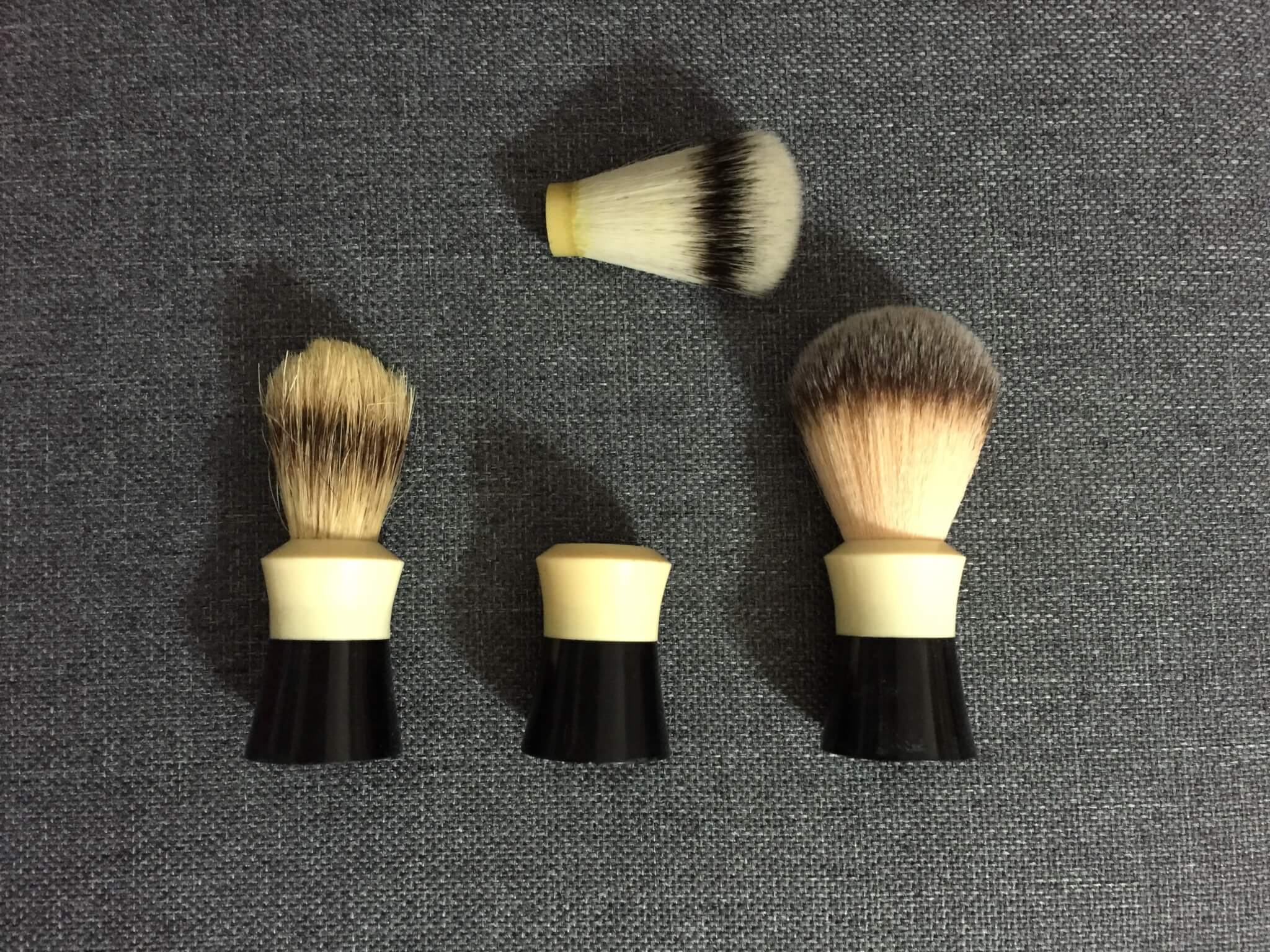
Maggard’s, Nathan Clarke, Whipped Dog, and others sell a synthetic knot in a range of sizes, from 20 on up to 26. You can buy a handle, or provide your own. In my case, I rehabilitated an EverReady 100T brush which used to hold a boar knot. In the old days, knots were commonly smaller than they are today. The EverReady shipped with a 20mm knot with very little shape or density to it. The example on the right in the picture now holds a 24mm knot. (The bare knot in the middle is a synthetic 19mm knot, which would be an easy substitute for the original, except it’s a bit springier than the others reviewed here.) To transplant a new knot isn’t hard if you’ve got a few tools. Cut off the hair close to the handle with a pair of scissors. Dremel out the old knot and increasing the diameter a bit with a sanding drum. Be careful not to go too deep; the handle is hollow. If you go through the floor where the knot is, be prepared to fill the handle with something (ball bearings, expanding foam) to take up the space in the handle, and then put a coin on top to act as the bottom depth of the hole for the knot. Glue the knot in. I like to test glue with hot melt. It holds for days to weeks, and if I don’t like the depth, it’s easy to pull out and re-set. Once I find the depth I like, I’ll glue a knot with silicone, which stays well and has the advantage I can pull the knot out again at a later time. You can set the knot with the glue plug just below the surface of the hole, or you can set it about 11mm deep, and really dial in how much the knot will spread or splay, and what backbone feel results you arrive at.
A Word on Shedding
To be very honest, all of these knots shed to a lesser or greater degree. The common statement from their sellers seems to be, this is alright, provided it stops doing it within the first week. Some users believe that a synthetic should not shed at all, but as long as it doesn’t lose too many, and doesn’t continue to lose fibers, it should not be a problem.
Summing Things Up
To be very honest, all of these brushes are similar. That’s sort of to be expected, given that they all use a similar fiber, similar knot size and loft. They should be repeatably good in production, where natural hair can vary from animal to animal and brush to brush. The greatest difference was between all of these and the Fine Stout, which had the most distinctly different feel on the face. There were smaller differences between the Classic and the rest of the brushes, just based on sheer size, but these were much less perceptible on the face. The 26mm Monster felt a bit more floppy. It’s easy to reach for any of them and have a good lather whipped up quickly. I find myself reaching for the Monster or either of the Fine brushes most frequently. Any one of these is going to be an excellent choice. We live at an excellent time in the spectrum of brushes available to us, at an affordable cost. There’s no reason to not get one of these if you’re at all curious.

My Omega boar will occasionally shed a single bristle, my horsehair will lose a rare hair, but my EJ Badger hasn’t shed a hair since new. None of my synthetics has lost a hair except for one from My Infinity. None of these brushes are new
Some knot providers will comb knots prior to sending them out in order to save the user the experience of seeing fibers divorce themselves from the knot.
Others don’t, and you see a few fibers here or there. None of the fiber loss witnessed here negatively changed how the brushes performed.
I have the Parker black and chrome synthetic brush. It is top notch-as soft as my silvertips. It creates a nice lather. I recommend this one. I do find that it is much better with creams than soaps though
That knot looks similar. No telling how deep it is set, but it looks to be a 22mm. Enjoy it!
Very nice review, Victor.
I’m a bit confused why some think synthetic brushes should never shed. Any brush can shed at bit, when new. All knots are a bunch of fine fibers tied together, so shedding is a possibility.
The big difference between natural and synthetic brushes is the initial smell, IMO. Synthetic brushes should never stink, when new. A boar or badger might smell a bit gamey before being washed for the first time–talk about bad first impressions. I’ve been lucky though. My favorite badger brushes came with very little scent, which washed right off.
Agree totally.
Boar brushes require break-in to really work their best, and after an extended time can wear out, or cease to lather as well -or so I’ve heard. Boar also requires more water to use, which can be off-putting to some.
Synthetics are as soft as they’ll ever be on their first day out of the box, and perform consistently for their useful life. Animals vary from animal to animal – some badger is amazing, some scratchy. Synthetics are uniformly soft.
For the price, it’s hard to imagine a better value-for-money if soft tips are the goal.
I think the reason why some folks like to use their brush for exfoliation is to release some of the hairs that may be trapped under some dead skin before shaving. I personally believe that the level of exfoliation that can be achieved from a good synthetic is nominal, because they aren’t scrubby enough to really do much. Perhaps a scratchy boar would work better for that purpose. Personally, I pretty much just use painting strokes to apply lather. I used to swirl, but have since changed my technique. I think painting strokes put less stress on the brush, while still adequately applying the lather.
Brushes don’t “lift up the whiskers.”
Scrubbing the face with a facial soap or loofah, or pulling a razor across the face exfoliate. Trying to use a brush for that just abuses the brush unneccesarily.
I bought the Maggard black handle in 22mm. I bought it as a travel brush, since reading that they dry quicker. BTW I got my travel tube from Maggard’s. I emailed them if the 24 would fit. They quickly sent back that it would not. They sent which ones would fit.
When it arrived I tried it out. I like it so much better than my EJ best badger. That the Maggard has become my daily and travel brush. Compared to my badger, it is softer. It is also a lather machine. No matter how little I work the soap, I get a mountain of lather.
I do like the handle, to each his own.
The knot in the Maggard’s is just fine. It’s certainly a popular brush from a reputable vendor, with top quality customer service.
The brush itself is great. I didn’t get along with the handle shape.
The standard Razorock Plissoft is less floppy than the monster IMO. It’s a fantastic face latherer for me personally.
That’s true – I didn’t compare the full range of RazoRock brushes because it seemed like the brushes would be very similar due to size of knot, and I wanted to get the widest differences covered.
Comments are closed.